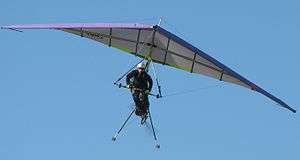Swedish Aerosport Mosquito
The Swedish Aerosport Mosquito is a Swedish powered hang glider designed and produced by Swedish Aerosport and introduced in 1995.[1][2]
| Mosquito | |
|---|---|
 | |
| Role | Powered hang glider |
| National origin | Sweden |
| Manufacturer | Swedish Aerosport |
| Introduction | 1995 |
| Status | In production |
| Unit cost |
US$5000 (2000 price) |
Design and development
The Mosquito was the power package that started renewed interest in the powered self-launching hang glider concept when it was introduced in 1995. The power package can be mated with any hang glider wing. Ready to fly the aircraft features a cable-braced hang glider-style high-wing, weight-shift controls, single-place accommodation, foot-launching and landing and a single engine in pusher configuration.[1]
The aircraft uses a standard hang glider wing, made from bolted-together aluminum tubing, with its wing covered in Dacron sailcloth. The wing is supported by a single tube-type kingpost and uses an "A" frame control bar. The engine is a lightweight, two-stroke, single cylinder Radne Raket 120 of 14 hp (10 kW) that produces power though a 3.5:1 belt reduction drive, with an extension shaft. Folding legs protect the propeller during ground operations. The engine package can be installed in most hang glider pod harnesses. The Mosquito can also be purchased as a complete harness assembly.[1]
The original Mosquito design was updated in 2001 as the Mosquito NRG, which remains in production. The NRG incorporates a flat back plate, front opening, propeller brake, integrated controls and electric starting.[2]
Wings that are approved for the Mosquito include the A-I-R Atos rigid wing and the Aeros Discus M.[3][4]
Specifications (Mosquito)
Data from Cliche[1]
General characteristics
- Crew: one
- Empty weight: 44 lb (20 kg) plus the wing weight
- Fuel capacity: 1.5 U.S. gallons (5.7 L; 1.2 imp gal)
- Powerplant: 1 × Radne Raket 120 single cylinder, two-stroke, air-cooled aircraft engine, 14 hp (10 kW)
Performance
- Cruise speed: 25 mph (40 km/h, 22 kn)
- Stall speed: 14 mph (23 km/h, 12 kn) depending on wing employed
- Endurance: About 2 hours
- Rate of climb: 400 ft/min (2.0 m/s)
Image gallery
- The harness attached to the glider when it is tethered nose down and into wind
- With full fuel the motorised harness weighs around 15 kg more than a standard hang gliding harness
- A Pegasus rigid wing hang glider with a Mosquito A10 harness, the model previous to the NRG
- The tail section of the keel is removed to prevent conflict with the propeller.
References
- Cliche, Andre: Ultralight Aircraft Shopper's Guide 8th Edition, page C-34. Cybair Limited Publishing, 2001. ISBN 0-9680628-1-4
- Bertrand, Noel; Rene Coulon; et al: World Directory of Leisure Aviation 2003-04, page 76. Pagefast Ltd, Lancaster OK, 2003. ISSN 1368-485X
- A-I-R GmbH (2 January 2012). "Model Overview, Facts and Data". Retrieved 1 February 2012.
- Aeros (2011). "Discus". Retrieved 2 February 2012.